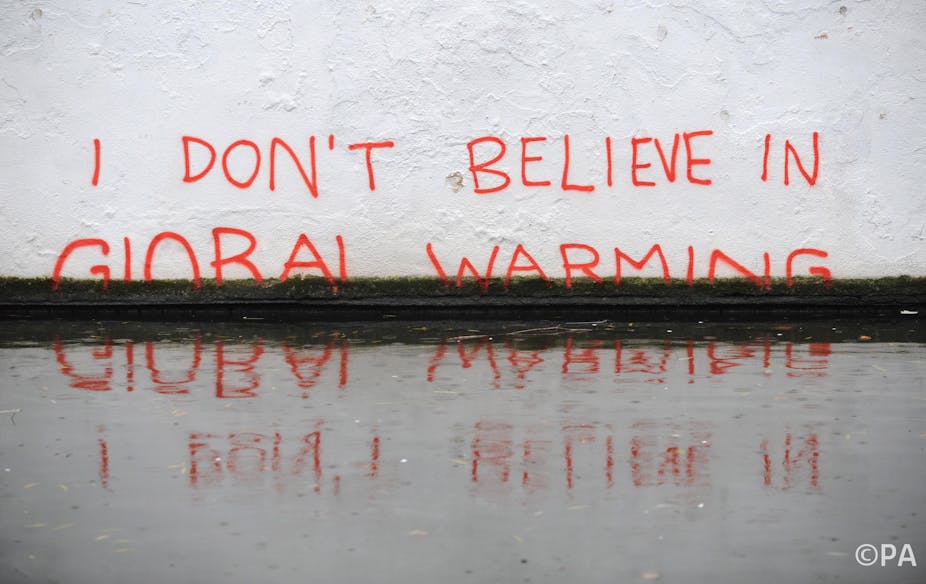In the run-up to the publication of the Fifth assessment report of the United Nations Intergovernmental Panel on Climate Change (IPCC) there is the usual flurry of activity among those with an interest in discrediting the substantial body of evidence demonstrating human influence on climate change.
Opinion pieces seem to generally follow the line: “the planet isn’t warming but if it is we are not the cause, and if we are the cause then it’s not important and may actually be beneficial …” (as neatly summarised by the Skeptical Science blog).
Sure enough, the Mail on Sunday published several inaccurate articles on climate change, which were then pounced upon and republished by various others such as the Telegraph in the UK and the Australian.
One of the most frequently misrepresented elements of climate science is the slowdown in global surface warming over the last 15 years. This fact, taken in isolation, is held as proof that human activity is not causing the climate to change. The latest science shows this to be false.
Changes in the sun’s rays, volcanic activity, particle air pollution and water vapour in the stratosphere may have contributed to the slowed rate of surface warming, reflecting some heat back into the atmosphere and so offsetting some of the heat caused by rising greenhouse gas concentrations.
However, since 2000, heating of the planet has in fact continued at a rate equivalent to more than 250 billion 1KW household electric heaters. This is based upon evidence from thousands of automated ocean buoys that measure down to a depth of nearly 2km, combined with global satellite data measuring radiative energy entering and leaving the planet.
Recent research indicates the current slowing in the rate of surface warming is primarily caused by natural ocean variability linked to La Niña conditions affecting the Pacific.
During the 1980s and 1990s, heating from greenhouse gases warmed the upper layers of the ocean, which affected global surface temperatures. In the 2000s, changes in ocean circulation have caused this additional heat energy to affect deeper layers beneath the sea surface as demonstrated using a combination of simulations and observations.

Warming has therefore not stopped and simulations which capture this natural variability indicate that we can expect substantial rates of surface warming to return over the coming decades in response to rising greenhouse gases.
Another line taken by sceptics in the popular media is that climate sensitivity (the amount of global warming caused by a doubling of CO2 concentrations) is low, in which case adding more greenhouse gas will not have a big effect on society. Previous IPCC reports have noted that the exact level of climate sensitivity is uncertain, ranging from around 1.5-4.5C.
Yet based upon observations, basic physics and detailed simulations we know rising temperatures cause increases in water vapour and diminishing surface ice which strongly amplify climate change (known as positive feedback) and explain why the middle of this range is close to 3C.
While recent studies have led to discussion of whether climate sensitivity is likely to be at the lowest end of the range, such a value would require substantial negative feedbacks. For example, increased reflection of sunlight by clouds as temperatures rise which, while possible, has not been observed.
And anyway, arguing over a few tenths of a degree in climate sensitivity masks the real issue: the damaging climate change expected in response to continued emissions of greenhouse gases, which are currently in line with worst case emissions scenarios used by the IPCC.
Other well-trodden climate sceptic claims that resurface regularly in the media refer to the warmth of the middle ages compared to today, suggest that Antarctic and Arctic ice is increasing, that CO2 levels have been higher than today’s, or that a rise in temperature increases CO2 levels, rather than the other way around.
These claims often confuse weather with climate and mix up processes that play out over hundreds, thousands or even millions of years. Crucially they largely ignore the vast body of evidence pointing to human influence on current and future climate change.
Entrenched views and confirmation bias apply to journalists, the public and scientist alike. But it’s important to consider why an opinion is voiced so fervently. In the case of the Mail on Sunday a hint is offered in an editorial piece which uses an accompanying article riddled with inaccuracies to reaffirm the paper’s apparent agenda against wind farms and in favour of fracking.
The climate is highly complex and there will always be debate over what is causing each lump and bump in the temperature record. The recent, much discussed slowdown in global surface warming is an example. The forthcoming IPCC report will be our best assessment of the science of climate change.
While it certainly cannot be considered perfect, it is built upon a vast body of evidence presented in the previous 2007 report, and will further demonstrate a clear connection between human activity and global warming, one that is set to increase in the near future, with ensuing serious consequences.

